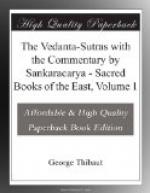Adhik. XVII (43-53) treats of the relation of the individual soul to Brahman. Sutra 43 declares that the individual soul is a part (a/ms/a) of Brahman, and the following Sutras show how that relation does not involve either that Brahman is affected by the imperfections, sufferings, &c. of the souls, or that one soul has to participate in the experiences of other souls. The two commentators of course take entirely different views of the doctrine that the soul is a part of Brahman. According to Ramanuja the souls are in reality parts of Brahman[14]; according to Sa@nkara the ‘a/ms/a’ of the Sutra must be understood to mean ‘a/ms/a iva,’ ‘a part as it were;’ the one universal indivisible Brahman having no real parts, but appearing to be divided owing to its limiting adjuncts.—One Sutra (50) in this adhikara/n/a calls for special notice. According to Sa@nkara the words ‘abhasa eva ka’ mean ‘(the soul is) a mere reflection,’ which, as the commentators remark, is a statement of the so-called pratibimbavada, i.e. the doctrine that the so-called individual soul is nothing but the reflection of the Self in the buddhi; while Sutra 43 had propounded the so-called ava/kkh/edavada, i.e. the doctrine that the soul is the highest Self in so far as limited by its adjuncts.—According to Ramanuja the abhasa of the Sutra has to be taken in the sense of hetvabhasa, a fallacious argument, and the Sutra is explained as being directed against the reasoning of those Vedantins according to whom the soul is Brahman in so far as limited by non-real adjuncts[15].
PADA IV.
Adhik. I, II, III (1-4; 5-6; 7) teach that the pra/n/as (by which generic name are denoted the buddhindriyas, karmen-driyas, and the manas) spring from Brahman; are eleven in number; and are of minute size (a/n/u).
Adhik. IV, V, VI (8; 9-12; 13) inform us also that the mukhya pra/n/a, i.e. the vital air, is produced from Brahman; that it is a principle distinct from air in general and from the pra/n/as discussed above; and that it is minute (a/n/u).
Adhik. VII and VIII (14-16; 17-19) teach that the pra/n/as are superintended and guided in their activity by special divinities, and that they are independent principles, not mere modifications of the mukhya pra/n/a.
Adhik. IX (20-22) declares that the evolution of names and forms (the namarupavyakara/n/a) is the work, not of the individual soul, but of the Lord.
Notes:
[Footnote 13: Lokavat, Yatha loke raja/s/asananuvartina/m/ ka rajanugrahanigrahak/ri/takhadukhayoges’pi na sa/s/ariraivamatre/n/a sasake rajany api sasananuv/ri/ttyauv/ri/ttinimittasukhadukhayor bhokt/ri/vaprasa@nga/h/. Yathaha Drami/d/abhashyakara/h/ yatha loke raja pra/k/uradanda/s/uke ghores’narthasa/m/ka/t/es’pi prade/s/e vartamanoszpi vyajanadyavadhutadeho doshair na sprisyate abhipreta/ms/ ka lokan paripipalayishati bhoga/ms/ ka gandhadin avi/s/vajanopabhogyan dharayati tathasau loke/s/varo bhramatsvasamait/h/ya/k/amato doshair na sp/ris/yate rakshati ka lokan brahmalokadi/ms/ kavi/s/vajanopabhogyan dharayatiti.]




